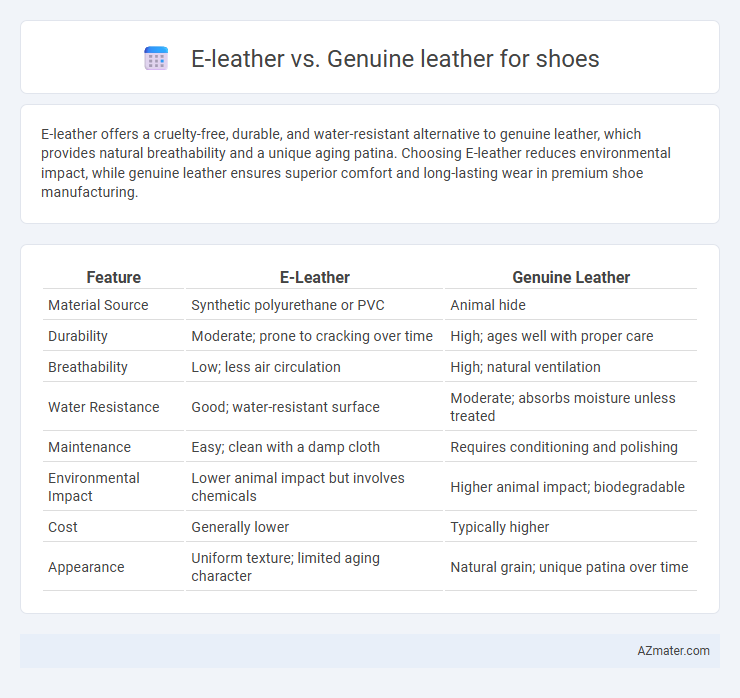E-leather offers a cruelty-free, durable, and water-resistant alternative to genuine leather, which provides natural breathability and a unique aging patina. Choosing E-leather reduces environmental impact, while genuine leather ensures superior comfort and long-lasting wear in premium shoe manufacturing.
Table of Comparison
| Feature | E-Leather | Genuine Leather |
|---|---|---|
| Material Source | Synthetic polyurethane or PVC | Animal hide |
| Durability | Moderate; prone to cracking over time | High; ages well with proper care |
| Breathability | Low; less air circulation | High; natural ventilation |
| Water Resistance | Good; water-resistant surface | Moderate; absorbs moisture unless treated |
| Maintenance | Easy; clean with a damp cloth | Requires conditioning and polishing |
| Environmental Impact | Lower animal impact but involves chemicals | Higher animal impact; biodegradable |
| Cost | Generally lower | Typically higher |
| Appearance | Uniform texture; limited aging character | Natural grain; unique patina over time |
Introduction to E-Leather and Genuine Leather
E-leather, made from synthetic fibers coated with polyurethane, offers a durable and water-resistant alternative to genuine leather, which is derived from animal hides through tanning processes. Genuine leather is prized for its natural breathability, flexibility, and aging characteristics, making it a preferred choice for high-quality shoes. E-leather provides an eco-friendlier and more affordable option while mimicking the appearance and texture of genuine leather footwear.
Composition and Manufacturing Process
E-leather consists of a synthetic polyurethane coating layered over a fabric base, designed to mimic the texture and appearance of genuine leather while being more environmentally friendly. Genuine leather is derived from animal hides, primarily cowhide, through a complex tanning process involving natural or chemical treatments to preserve and strengthen the material. The manufacturing of e-leather involves less water and chemical usage compared to the traditional tanning and finishing processes required for genuine leather, resulting in a more sustainable production method.
Environmental Impact: E-Leather vs Genuine Leather
E-leather significantly reduces environmental impact by utilizing synthetic or plant-based materials that require less water and generate fewer greenhouse gas emissions compared to genuine leather, which involves resource-intensive cattle farming and toxic chemical tanning processes. Production of genuine leather contributes to deforestation, methane emissions, and pollution from chromium-based tanning, posing sustainability challenges. E-leather alternatives offer a lower carbon footprint and decreased waste, making them a more eco-friendly choice in sustainable footwear manufacturing.
Durability and Longevity Comparison
E-leather offers consistent durability by resisting water, stains, and scratches, making it ideal for long-term use in shoes exposed to varying conditions. Genuine leather, known for its natural toughness and ability to develop a unique patina over time, often surpasses synthetic alternatives in longevity when properly maintained. However, genuine leather may require regular conditioning to prevent cracking, whereas e-leather maintains its structural integrity with minimal upkeep.
Comfort and Breathability Factors
E-leather offers a lightweight and flexible option, often incorporating synthetic fibers that enhance moisture-wicking and breathability, making it suitable for prolonged wear. Genuine leather provides natural breathability and molds to the foot over time, offering superior comfort and temperature regulation. Both materials balance comfort and breathability differently, with genuine leather excelling in long-term adaptability and e-leather delivering consistent ventilation and softness.
Style, Appearance, and Texture Differences
E-leather offers a consistent, smooth texture with a modern, uniform appearance that resists creasing and stains, making it ideal for sleek, contemporary shoe designs. Genuine leather features natural grain patterns and variations, providing a rich, unique aesthetic and a supple texture that softens and molds over time for a personalized fit. Style-wise, genuine leather often conveys a classic, luxurious appeal, whereas e-leather suits fashion-forward, eco-conscious consumers seeking durability and easy maintenance.
Cost and Pricing Considerations
E-leather typically offers a more affordable price point compared to genuine leather due to lower material and manufacturing costs, making it a cost-effective option for budget-conscious consumers. Genuine leather shoes often demand higher prices because of the labor-intensive tanning process and durability associated with natural hide. Buyers should weigh the initial investment in genuine leather against the potentially lower replacement frequency, while e-leather provides immediate savings but may wear out sooner.
Maintenance and Care Requirements
E-leather requires minimal maintenance, needing only occasional wiping with a damp cloth to remove dirt and prevent smudges, making it highly durable against stains and water damage. Genuine leather demands more rigorous care, including regular conditioning with leather creams to maintain its suppleness and prevent cracking, alongside cleaning with specific leather cleaners to preserve its natural texture. Proper maintenance of genuine leather shoes extends their lifespan significantly but involves more time and products compared to the low-maintenance nature of e-leather footwear.
Ethical and Animal Welfare Perspectives
E-leather offers an ethical alternative to genuine leather by eliminating the need to harm animals, appealing to consumers concerned with animal welfare and cruelty-free fashion. Genuine leather involves the use of animal hides, often contributing to ethical debates over livestock treatment and environmental impact. The rise in demand for vegan and sustainable products drives innovation in E-leather, supporting animal rights while reducing the carbon footprint associated with traditional leather production.
Which Is Better for Shoes: E-Leather or Genuine Leather?
E-leather offers durability, water resistance, and eco-friendliness, making it ideal for budget-conscious and vegan consumers seeking stylish, low-maintenance shoes. Genuine leather provides superior breathability, natural flexibility, and long-lasting comfort, preferred by those prioritizing classic quality and premium craftsmanship. Choosing between e-leather and genuine leather depends on factors like environmental impact, durability needs, and personal preferences for texture and aging characteristics.

Infographic: E-leather vs Genuine leather for Shoe
 azmater.com
azmater.com